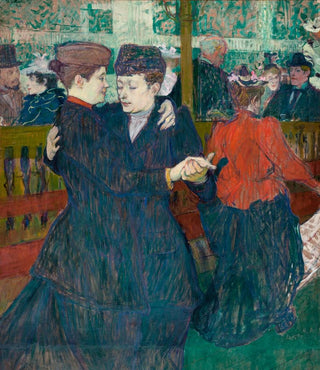Art print | At the Moulin Rouge, two women waltz - Henri de Toulouse-Lautrec


View from behind

Frame (optional)
In the vibrant universe of the Belle Époque, the artwork "Au Moulin Rouge, deux femmes valsent" by Henri de Toulouse-Lautrec emerges as a poignant testament to Parisian nightlife. The scene, full of movement and sensuality, captures the very essence of cabarets—places of gathering and celebration where joie de vivre blends with a touch of melancholy. This art print invites viewers to immerse themselves in a world where dimmed lights and laughter resonate, revealing the intimate stories of its characters while celebrating the art of spectacle. The dynamic between the two women, caught in dance, evokes a sense of complicity and freedom that transcends the boundaries of their era, making this piece a true masterpiece of modern art.
Style and uniqueness of the work
Toulouse-Lautrec's style is distinguished by its boldness and originality, qualities that are fully expressed in this art print. The artist, with his swift brushstrokes and vibrant color palette, manages to convey an electric atmosphere, almost tangible. The stylized forms of the dancers, accentuated by fluid lines, create a sensation of continuous movement, as if the painting is in perpetual evolution. The faces of the women, though simplified, express a range of emotions, from joy to introspection. This ability to capture fleeting moments, to immortalize the magic of a life moment, is what gives the work its undeniable singularity. Toulouse-Lautrec does not merely depict reality; he reinvents it, transforming it into a sensory experience where the viewer is invited to feel rather than simply observe.
The artist and his influence
Henri de Toulouse-Lautrec, an iconic figure of the late 19th century, established himself as a pioneer of modern art. His journey, marked by fragile health and a tumultuous life, led him to frequent the artistic and bohemian circles of Paris, where he drew his inspiration. His sharp eye on society of his time, combined with innovative techniques, allowed him to create a rich and varied body of work. Toulouse

Matte finish

View from behind

Frame (optional)
In the vibrant universe of the Belle Époque, the artwork "Au Moulin Rouge, deux femmes valsent" by Henri de Toulouse-Lautrec emerges as a poignant testament to Parisian nightlife. The scene, full of movement and sensuality, captures the very essence of cabarets—places of gathering and celebration where joie de vivre blends with a touch of melancholy. This art print invites viewers to immerse themselves in a world where dimmed lights and laughter resonate, revealing the intimate stories of its characters while celebrating the art of spectacle. The dynamic between the two women, caught in dance, evokes a sense of complicity and freedom that transcends the boundaries of their era, making this piece a true masterpiece of modern art.
Style and uniqueness of the work
Toulouse-Lautrec's style is distinguished by its boldness and originality, qualities that are fully expressed in this art print. The artist, with his swift brushstrokes and vibrant color palette, manages to convey an electric atmosphere, almost tangible. The stylized forms of the dancers, accentuated by fluid lines, create a sensation of continuous movement, as if the painting is in perpetual evolution. The faces of the women, though simplified, express a range of emotions, from joy to introspection. This ability to capture fleeting moments, to immortalize the magic of a life moment, is what gives the work its undeniable singularity. Toulouse-Lautrec does not merely depict reality; he reinvents it, transforming it into a sensory experience where the viewer is invited to feel rather than simply observe.
The artist and his influence
Henri de Toulouse-Lautrec, an iconic figure of the late 19th century, established himself as a pioneer of modern art. His journey, marked by fragile health and a tumultuous life, led him to frequent the artistic and bohemian circles of Paris, where he drew his inspiration. His sharp eye on society of his time, combined with innovative techniques, allowed him to create a rich and varied body of work. Toulouse






